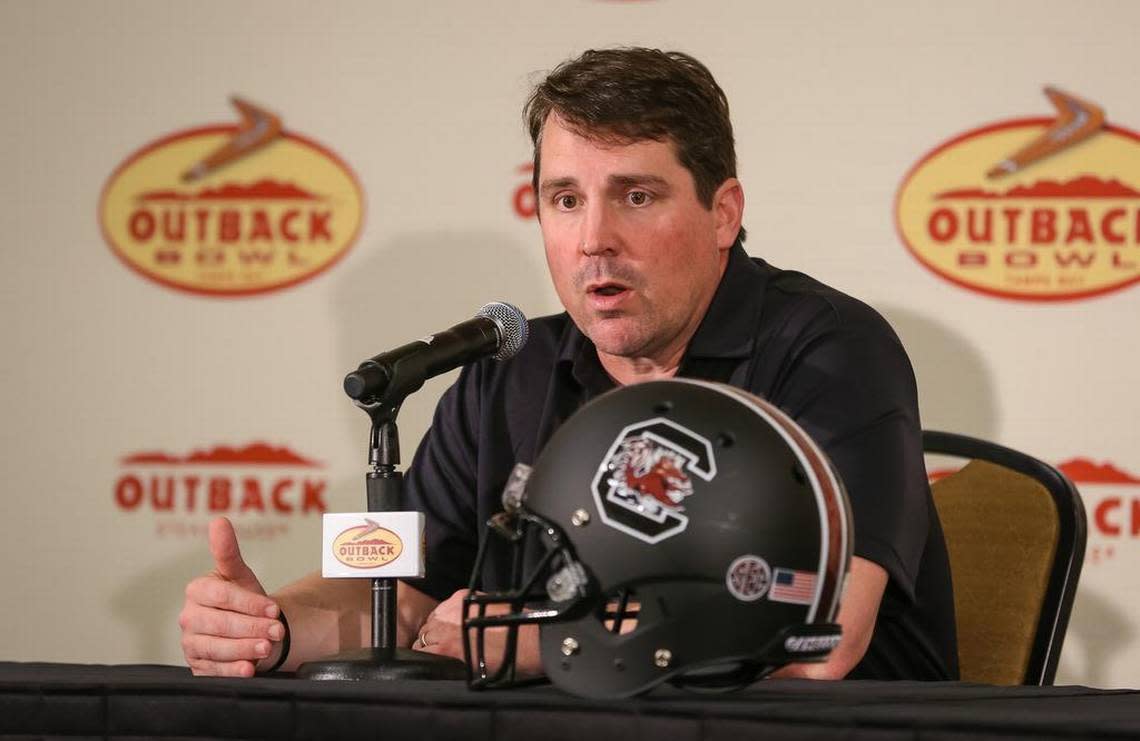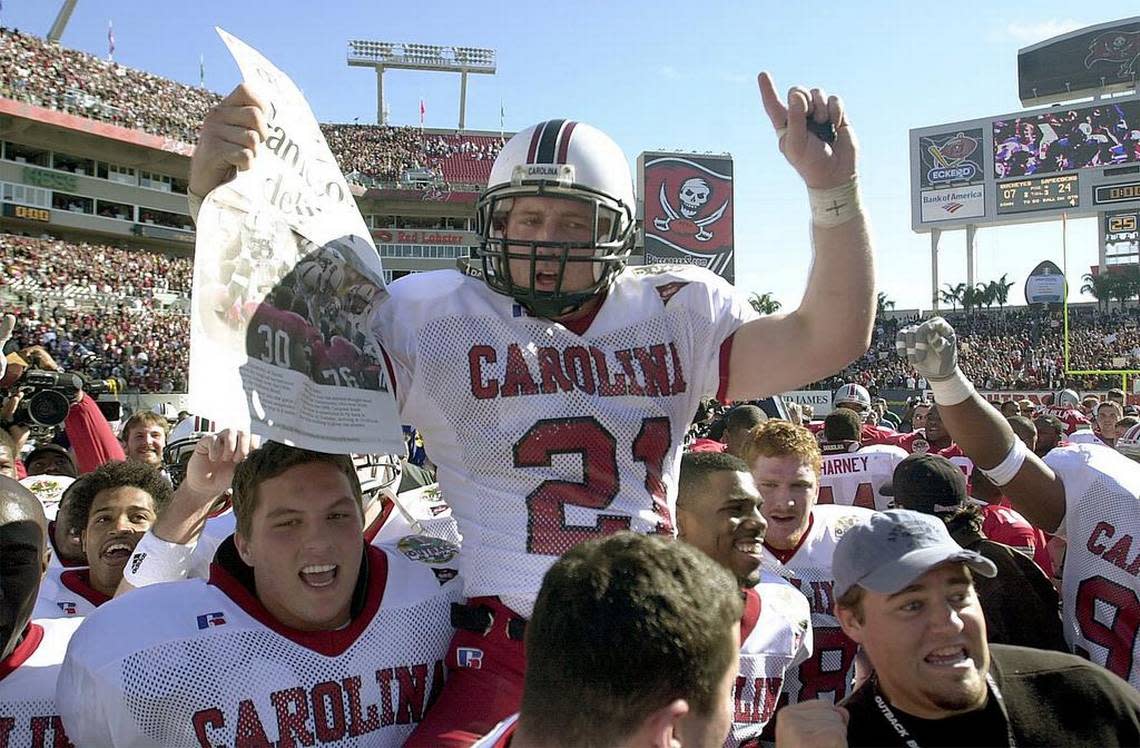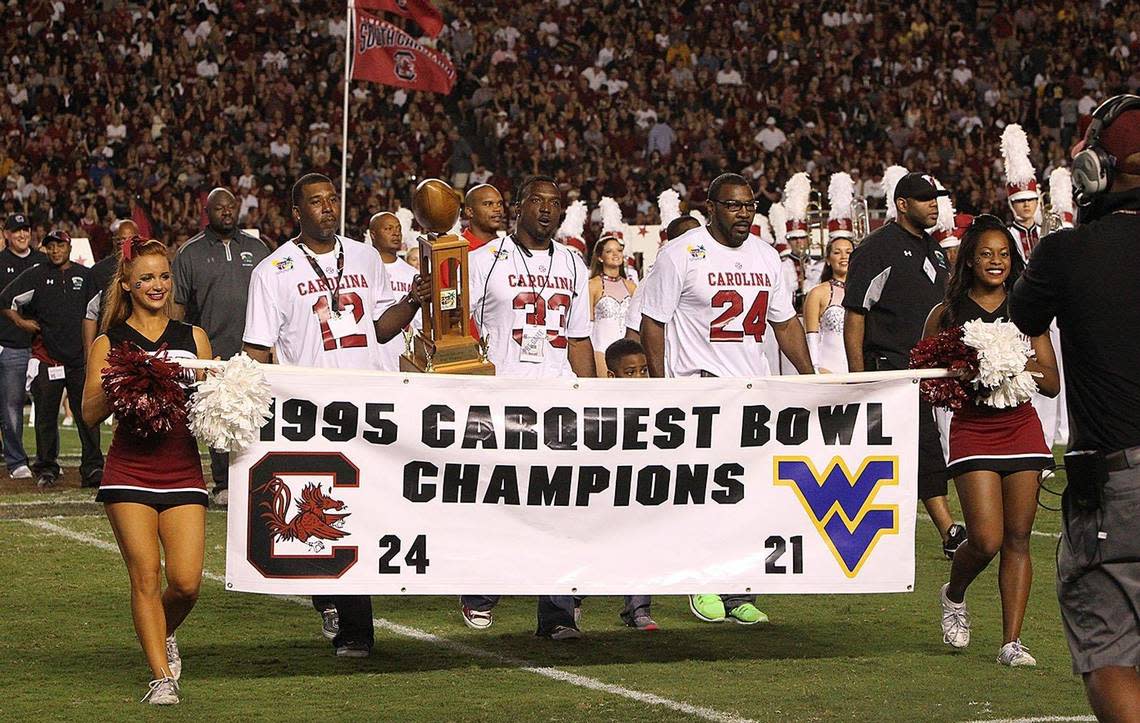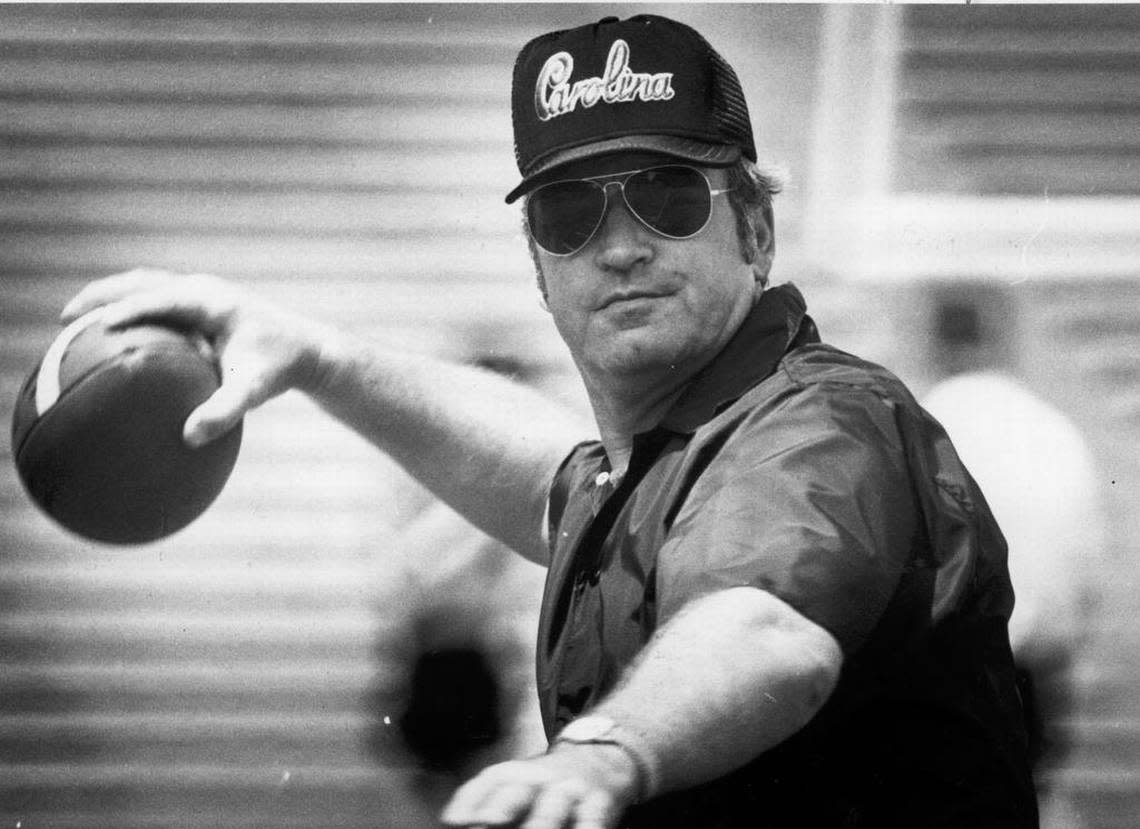Morrison, Muschamp, Holtz have this in common: Year 2 as Gamecocks coach was memorable
A first-year surprise caught some attention. Now Shane Beamer is up for the encore with his South Carolina football team.
There’s a little history of second-year magic in college football. Since 2000, four national championships have come in a coach’s second year. There have been a few other title-game trips or big breakthroughs from second-year coaches. Even the Gamecocks’ own history has some lofty moments in the season after a coach gets their feet wet.
USC has certainly built a bit of hype this offseason, adding transfer quarterback Spencer Rattler and assembling potential at the skill positions. Their story is yet to be written.
Until then, we can look to the past to see how Year 2s have treated previous Gamecocks coaches — plus how a few familiar faces on opposing sidelines fared in their second seasons.
Will Muschamp, Year 2 (2017)
Change in record: Gained 3 wins (6-7 to 9-4)
Offensive points per game rank change: up 15 spots (116th to 99th)
Defensive points allowed per game rank change: up 26 spots (51st to 25th)
Will Muschamp’s second Gamecocks squad proved his best and felt like a breakthrough, albeit one that proved to be built on less than stable ground. After a 3-2 start that included a miraculous last-second win against Louisiana Tech, South Carolina rode a solid defense and uneven offense to a 6-2 finish. The only losses were to College Football Playoff teams, but the wins were often close, and came against a schedule that went from daunting to soft. A comeback win against a decent Michigan team in the Outback Bowl proved the program’s high-water mark under its last coach.

Steve Spurrier, Year 2 (2006)
Change in record: Gained 1 win (7-5 to 8-5)
Offensive points per game rank change: up 31 spots (75th to 44th)
Defensive points allowed per game rank change: up 11 spots (40th to 29th)
The second Gamecocks team of the Spurrier era played much better than the first, but didn’t have all that much to show for it. The SEC produced six ranked teams, all of which spent time in the top 10. South Carolina played five of those six teams — and lost them all — four by seven points or fewer. The squad split its QB position, but wide receivers Sidney Rice and Kenny McKinley put up numbers, while the likes of Jasper Brinkley, Eric Norwood and Captain Munnerlyn led a feisty defense. The program was stable for the next few years before finally breaking through in 2010.
Lou Holtz, Year 2 (2000)
Change in record: Gained 8 wins (0 to 8)
Offensive points per game rank change: up 42 spots (114th to 72nd)
Defensive points allowed per game rank change: up 52 spots (58th to 6th)
The turnaround was one of the biggest on record, and shows how things can change quickly (also how close things really are in football). After the worst season in program history, Holtz’s program relied on a powerhouse defense that included Kalimba Edwards, Sheldon Brown and Andre Goodman, plus the downhill running power of Derek Watson and Andrew Pinnock behind QB Phil Petty. Those Gamecocks upset ranked Georgia and Mississippi State before smothering Ohio State in the Outback Bowl. Holtz’s next team went on to win nine games the next year, before the program fell back in his later seasons.

Brad Scott, Year 2 (1995)
Change in record: Lost 3 wins (7-5 to 4-6-1)
Offensive points per game rank change: up 44 spots (53rd to 9th)
Defensive points allowed per game rank change: down 53 spots (46th to 99th)
After leading the Gamecocks to their first bowl win in program history, Scott turbocharged the Gamecocks’ attack with Steve Taneyhill handing off to Duce Staley and throwing to the likes of Zola Davis, Stanley Pritchett and Monty Means. The problem was the defense that came apart, allowing 35 points in seven of 11 games and 42 points four times. The best win was against a 3-8 Mississippi State team, and the Brad Scott era never got on track again.

Sparky Woods, Year 2 (1990)
Change in record: Gained 0 wins (6-4-1 to 6-5)
Offensive points per game rank change: up 27 spots (69th to 42nd)
Defensive points allowed per game rank change: up 3 spots (47th to 44th)
Woods’ first season showed promise, with no bad losses and a win against a ranked Georgia team in Athens. But Year 2 didn’t build on it. The 1990 Gamecocks won more comfortably against most of the worse and middling teams on their schedule. A loss to eventual co-national champion Georgia Tech ended a one-week stint in the rankings, and a loss to 1-AA The Citadel was a dark mark on the schedule. The campaign was the last winning one under Woods.
Joe Morrison, Year 2 (1984)
Change in record: Gained 5 wins (5-6 to 10-2)
Offensive points per game rank change: up 56 spots (67th to 11th)
Defensive points allowed per game rank change: down 6 spots spots (56th to 62nd)
Year 2 under Joe Morrison delivered what was the banner season for the program until the 2010s. New quarterback Mike Hold led a multifaceted option offense with a deep stable of play-makers. The blitz-heavy “Fire Ants” defense held its own to complement that attack, as the Gamecocks marched out to 9-0. An upset loss to Navy ended the dream of a national title, but a 10-2 campaign still finished with a win against Clemson and a battle in the Gator Bowl against Oklahoma State. Morrison’s next two teams scuffled before bouncing back in 1987 and 1988.

Average change
Wins: Increased by 2.3 in Year 2
Offensive points per game rank: Increased by 35.8 spots
Defensive points allowed per game rank: Increased by 5.5 spots
——— Elsewhere in the sport ... ———
Only four of South Carolina’s seven permanent SEC opponents even have coaches who’ve completed two seasons. The results of those coaches’ second years were mixed, as were those for a few other faces you’ll see in Williams-Brice Stadium this fall.
Kirby Smart, Georgia, Year 2 (2017)
Change in record: Gained 5 wins (8 to 13)
Offensive points per game rank change: Up 82 spots (102nd to 20th)
Defensive points allowed per game rank change: Up 29 spots (35th to 6th)
Smart’s Year 1 to 2 switch was a case of going from a scuffling defense-first squad to one that was separated only by a sports miracle from winning the whole dang thing. His second-year Bulldogs found their dominant defensive footing and had the offense come together behind a backup quarterback and stable of freak running backs. Only an overtime bomb against a busted coverage in the national title game against Alabama denied that 13-2 squad a title. Smart had to wait another half-decade for a national championship, but his run showed what Year 2 can be, albeit at one of the most talent-rich programs in the land.
Mark Stoops, Kentucky, Year 2 (2014)
Change in record: Gained 3 wins (2-10 to 5-7)
Offensive points per game rank change: Up 45 spots (108th to 63rd)
Defensive points allowed per game rank change: Down six spots (90th to 96th)
Stoops didn’t deliver a winning record in Year 2, but he certainly boosted the fortunes of a consistent cellar dweller. The Wildcats went from 10 losses to a game below .500. It came with a faster pace, modest improvement on both sides of the ball, and upsets of Florida and South Carolina (a particularly defensively vulnerable Gamecocks group). Other than a deep backfield, that group didn’t quite hint at the program UK has grown into. Stoops took until Year 4 to reach a bowl, but hasn’t missed one since and delivered a pair of 10-win seasons.
Eli Drinkwitz, Missouri, Year 2 (2021)
Change in record: Gained 1 win (5-5 to 6-7)
Offensive points per game rank change: Up 18 spots (79th to 61st)
Defensive points allowed per game rank change: Down 28 spots (85th to 113th)
Drinkwitz’s first season came during the pandemic, but he left his second with some lingering questions. The offense built around some nice play-makers, notably Tyler Badie, and OK quarterback play. The defense was simply not very good. The best win on the slate was either against scuffling Florida or an inconsistent Gamecocks group. The year ended with a last-second loss to Army in the bowl game. Considering it followed a somewhat successful debut, this was probably not the encore Mizzou’s fans had hoped for.
Jimbo Fisher, Texas A&M, Year 2 (2019)
Change in record: Dropped 1 win (9-4 to 8-5)
Offensive points per game rank change: Down 43 spots (19th to 62nd)
Defensive points allowed per game rank change: Up 8 spots (47th to 39th)
Fisher already had the experience of eight years as a Power 5 coach when he took over the Aggies, and his second season was perhaps capped by a simply brutal schedule. The Aggies got worse statistically. They also faced Nos. 1, 2, 4, 8 and 14 in the final AP poll, and lost to all of them. For that reason, it didn’t seem to put too much of a damper after Jimbo’s first squad won nine games. His next team went 9-1, despite maybe not being as good as its record, and now the program is feeling good with a monster recruiting class off an 8-4 season that featured an upset of Alabama.
Shawn Elliott, Georgia State, Year 2 (2018)
Change in record: Dropped 5 wins (7-5 to 2-10)
Offensive points per game rank change: Up 13 spots (117th to 104th)
Defensive points allowed per game rank change: Down 74 spots (48th to 122nd)
Elliott had half a season as steward of the end of the Spurrier era, and started his time at GSU with a bowl trip. But unlike many Years 2 mentioned above, his was one of transition. A senior QB gave way to a junior college transfer, and the defense cratered in a massive way. The Panthers narrowly edged Kennesaw State to open the year, and mostly struggled from there. That said, Year 2 was not defining for Elliott. The offense has rebounded in the image and style he prefers (a modern, versatile, ground-heavy attack). The defense’s progress took time but also stabilized. Elliott’s last three teams have been above .500, no small feat at a mid-level Sun Belt program without much history.
Frank Beamer, Virginia Tech, Year 2 (1988)
Change in record: Gained 1 win (2-9 to 3-8)
Offensive points per game rank change: Down 12 spots (82nd to 94th)
Defensive points allowed per game rank change: Up 22 spots (80th to 62nd)
Shane Beamer’s father had the slow-build experience when it came to a second year. Taking over a struggling program, the group got a little better, still struggling against a mostly independent schedule. The offense only managed 16 points per game, but the defense held five opponents at or below that mark. Beamer went on to lead two winning teams the next two seasons, sliding back the two years after, and then starting his Hall of Fame run.
